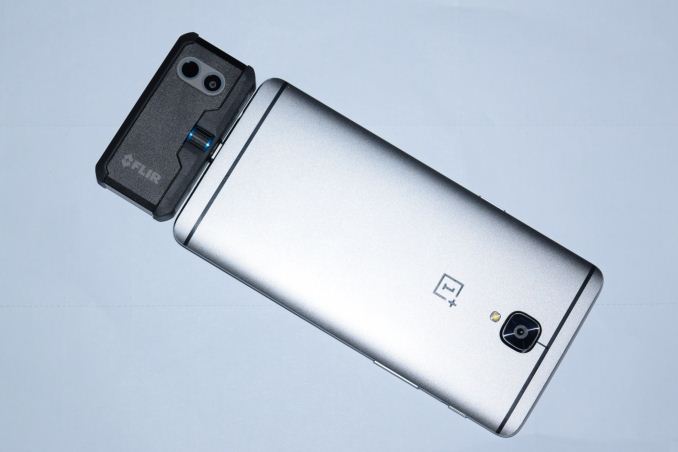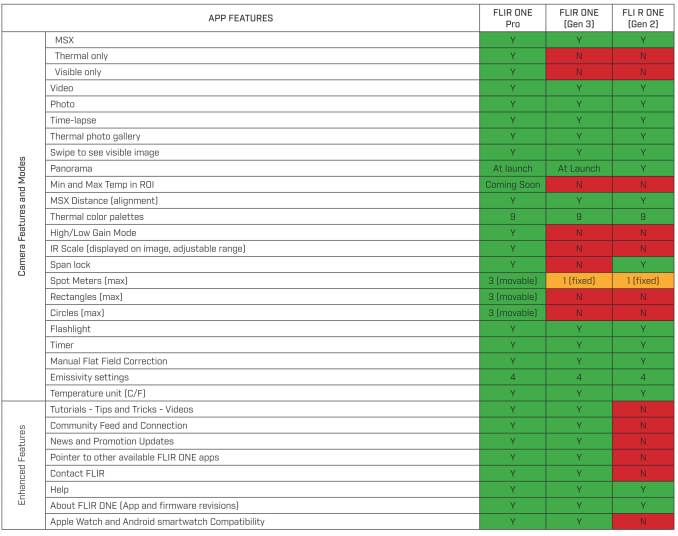FLIR ONE Pro Thermal Camera Review
by Ganesh T S on June 6, 2017 8:45 AM EST- Posted in
- Gadgets
- Thermal Imaging
- FLIR
- USB-C
Concluding Remarks
FLIR is making two affordable thermal imagers available for sale today. While the FLIR ONE caters to the casual users, the FLIR ONE Pro caters to power users and professionals. Thermal imagers are especially effective for diagnosing issues around the home or job site that are difficult to spot with the naked eye. Examples include spotting an overloaded circuit or identifying a switch that is beginning to fail and determining the exact location of plumbing issues like clogged pipes or water leaks (that are not readily visible). Identification of insulation issues is an oft-cited example. But, in addition, it can also be used to identify critter nesting areas, or even lost pets. A smartphone along with either the FLIR ONE or the FLIR ONE Pro can help in all these cases and more.
The FLIR ONE Pro hardware build quality is excellent, and there is really nothing to complain about in that aspect. The majority of the user experience falls back on the app side. The FLIR One Android app's user interface could be a bit more simple, but, considering that a professional tool needs to be able to present all the tweaks and knobs to the end-user, it makes sense. The split-up of features between the FLIR One and the FLIR Tools apps works well. We would like some features in the latter (such as the automatic recognition of the highest and lowest temperatures in the frame) to be available in the FLIR ONE's preview pane also.
FLIR requires verified online accounts for the usage of the new FLIR One app and the FLIR Tools app. However, the two accounts are distinct ones. FLIR indicated that they plan to have a single sign-on program in the future, but, consumers need separate accounts for now.
It is mandatory to be connected to the Internet when first launching the FLIR One app. Thankfully, subsequent usage doesn't require the user to be online (though the beta app that we used kept pushing a sign-in error notification even after disconnecting the FLIR ONE Pro from the smartphone). The app was also a little bit flaky - the remaining battery charge indication would occasionally show some obviously wrong values, and the UI would sometimes get garbled up. But, these issues were quite rare, and I am quite sure that FLIR will be updating the app regularly before the first set of units ship to the consumers later this month.
Moving on from the aspects that need improvement, we have to give credit to FLIR for OneFit adjustable connector feature that enables usage of the add-on module even with mobile devices enclosed in cases. The USB-C connector for the Android version solves the orientation issue that consumers faced with the previous generation FLIR ONE units. The built-in battery ensures that the add-on does not negatively affect the battery life of the mobile device. The new features of the FLIR One app are also welcome. Though I am not a big fan of the social aspects of the app (such as the community feeds etc.), I am sure some customers might appreciate the feature. The smartwatch compatibility of the app (that allows the mobile device to be placed in slightly inaccessible locations, while still being able to get a preview from the thermal imager and trigger recording on a smartwatch) is also very useful. Even though the new FLIR One app is compatible with all of the FLIR ONE units in the market, the features activated in the app are dependent on the hardware. The following table provides a detailed summary of how the app behavior varies with the device.
The 3rd Gen. FLIR ONE is priced at $200 (compared to the $250 launch price of the previous generation), while the FLIR ONE Pro comes in at $400. FLIR indicated that a micro-USB Android version of both devices will also become available later this summer. The closest competitor to the FLIR ONE Pro (in terms of target market and feature set) is Seek Thermal's CompactPRO. It boasts a much higher thermal sensor resolution (320 x 240) compared to the Lepton 3 (160 x 120) in the FLIR ONE Pro. However, it doesn't have a camera for the visible spectrum, and lacks the advanced blending features such as FLIR's MSX. With the Seek Thermal CompactPRO being priced close to $500, we believe that the FLIR ONE Pro has a significant edge despite sporting a sensor with just a quarter of the pixels.












40 Comments
View All Comments
RandomUsername3245 - Tuesday, June 6, 2017 - link
I believe FLIR typically quotes +/-5ºC on their spec sheet. In my experience, it is better than this. Also, there is a cap on the maximum intensity read out on this camera which is apparently set to 150ºC. Similar FLIR microbolometers can go way higher than this without saturating, so this is just a software limitation.JanW1 - Wednesday, June 7, 2017 - link
Sorry, my June 7 comment was meant to go here, not above...JanW1 - Wednesday, June 7, 2017 - link
Oh, so now it went back below to where it was supposed to be - edit function, maybe?JanW1 - Wednesday, June 7, 2017 - link
Isn't the goal of reviews to independently test the manufacturers claims? Of course I can read spec sheets, but then why review it? There are plenty of example pictures available from FLIR's website already.The review states that there is a cap of 400°C - that's way beyond the 150.3°C shown in this sample picture. Did Ganesh set the range to top out at 150.3°C (302.5°F) before taking that picture? That seems somehow unlikely. Or was the picture taken immediately after turning the burner on? But then, isn't the minimum temperature of 31°C reported for that entire frame kind of high? A serious review should include at least a few words about whether the results seem reasonable given the circumstances - otherwise, what's the point?
ThermalImager - Wednesday, June 7, 2017 - link
Unfortunately Anandtech's thermal imaging reviews aren't very useful. The key criteria when selecting a thermal imaging device for most applications is sensitivity - i.e. the minimum resolution of temperature it can distinguish, typically represented in terms of mK (millikelvin i.e. 1/1000 C). The previous Flir One was a little vague, the spec quotes 'as small as 0.1C' i.e. 100mK. Seek thermal state 100mK but only report in 1C increments - something which is difficult to interpret and may render their sensors useless for thermal imaging. A good thermal imaging camera will have a sensitivity of 70mK or less.Resolution is also useful, but you can compensate for poor resolution by moving closer, into the object, also some cameras compensate for poor resolution by clever image processing.
I carry out thermal imaging surveys professionally, so have some idea about this subject.
jabber - Tuesday, June 6, 2017 - link
So when are going to get a phone with this built it? Two years?wolfemane - Tuesday, June 6, 2017 - link
That's a lot of hardware to add to the internals of a phone. I wouldn't count on anything close to the quality of a FLiR system in a cell phone anytime soon... if at all.jabber - Tuesday, June 6, 2017 - link
It doesn't have to be in a 2mm thick 'marmoset' phone. It can go into one a normal human male can carry. I'm still fine with the idea of a 10mm thick phone with a big battery even more so if it has actually useful features.Mr Perfect - Tuesday, June 6, 2017 - link
The Cat S60 linked to on the first page of the article is just what you're looking for.Mr Perfect - Tuesday, June 6, 2017 - link
These things are pretty cool, and the reviews are fun to read too.In future articles, maybe you could show us example shots that appeal to our inner geeks? Pictures of things that give us a reason to buy one, like shots showing how to detect IT equipment that needs dust cleaned out, or a VRM that needs a heatsink. Something we can justify the price with.